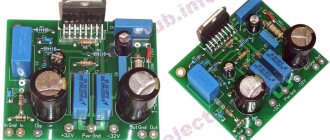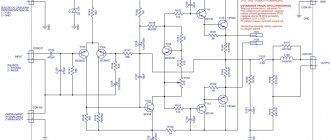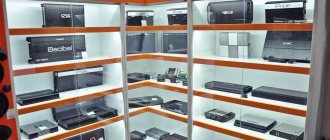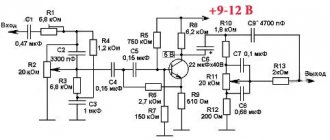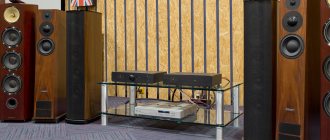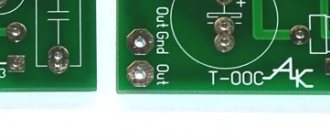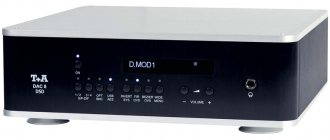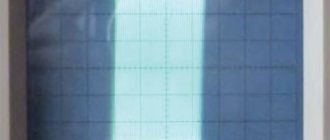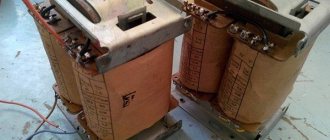One day, on a frosty December evening, boredom attacked me, I wanted to solder circuits, etch boards, but what kind, my darling did not yet understand. As a true fan of tube sound and a guitarist, I built myself a wide variety of tube amps - a stereo computer amp, a 40-watt guitar amp, a whole bunch of pedals and effects. I wanted something “like that,” ambitious and big... What don’t I have? And then it dawned on me, I don’t have a 5.1 system!
↑ System architecture 5.1
As you can see in the figure, a 5.1 system consists of a rear pair of speakers, a front pair, a center speaker and a subwoofer.
For comfortable use of this system, it is necessary to correctly place the speakers in the room and maintain the power ratio between them. Such systems are used for dubbing films, games, music, in general, anything that has a 6-channel separation of tracks. In the case of films and games, sound tracks are output to the speakers according to the following principle: front pair - main sound effects, voices on the right and left, center speaker - voice, rear pair - background effects, subwoofer - bass component of the effects. The balance of the entire system is very important so that the side voice does not drown out the central one, or the background effects do not interrupt the front ones.
Having understood this principle, I moved on to the problem of power. I planned to install this system in the hall, roughly figured out where which speakers would be placed, and moved directly to the problem of power. From my own experience, I know that when you turn on a 10 Watt terminal at full power, the room becomes somewhat uncomfortable. As a result, it was decided to make the front pair on push-pull circuits with 6P14P output lamps with a power of 10 W, and the central speaker and rear pair on single-cycle circuits with the same 6P14P output. The subwoofer was a separate issue for me, since I already had a 40-watt tube end, all I had to do was come up with a driver for it.
The power supply for five ECC83S and seven 6P14P lamps promised to be quite bulky. Having thought about what and how many transformers are needed for this task, I went in search of treasures. These treasures were collected in about a week. I managed to get TN-60 for filament of all lamps, two TA-166 for the anode and three D-47 chokes for filters. This pleasure did not come cheap, but I knew what I was getting into when I conceived this project.
Everyone usually starts with the case, but I decided for myself that I would first make the boards, and then weld a box of iron sheets for them, into which everything would fit.
Wireless interfaces
In the last few years, thanks to the development of mobile and portable technology, manufacturers have built Bluetooth, Wi-Fi, and DLNA network modules into almost every receiver. Thanks to them, the receiver became a source of not only FM radio, but also received the function of playing Internet radio stations, various online music services, and also began to be controlled from a smartphone (running Android or iOS). In addition, you can now listen to music from your smartphone not only by connecting it with a cable, but also without using wires - thanks to the AirPlay or ChromeCast function. You just need to connect the receiver to the local network wired or wireless.
↑ Three-channel amplifier circuit
It was decided to start with 3 channels on single-ended circuits.
Fragment excluded. The full version is available to patrons and full members of the community.
I decided to heat the preamplifier and output tubes with direct current. The ECC83S lamp heater operates from a stable voltage of +12.6V. You may have already seen a similar rectifier circuit more than once in my articles, but I’ll repeat it again - you need to solder a diode to the middle leg of the 7812 stabilizer, the voltage drop across which will be 0.6V, which is added to the main 12V output and the result is 12.6V. The current consumption of three ECC83S lamps is 450mA, so installing a heatsink on the 7812 chip is mandatory.
He initially planned to heat the 6P14P output lamps using a 5A adjustable stabilizer, but having approximately calculated the minimum required radiator area at a current of 3A, he abandoned this idea due to its bulkiness. Therefore, I simply assembled a rectifier with a filter. The separation of the primary and secondary filter is carried out by the KD213 diode. The filament output voltage under load is 6V.
The anode supply is organized by a classic U-shaped filter “capacity 100 uF – choke – capacity 220 uF”. In my opinion, this is quite sufficient if there is a D-47 throttle.
The circuit itself is the simplest - “preamplifier - emitter follower - terminal”. The signal level is adjusted using potentiometers located in the gap between the preamplifier and the emitter follower. The level adjustment of the central channel is connected to one potentiometer, but the two rear channels are connected to one dual potentiometer to simultaneously adjust the levels.
Choosing compact audio power amplifiers for mini systems on Aliexpress
Today's post is dedicated to ready-made mini power amplifiers. This is a compact and inexpensive solution for the audiophile's secondary sound system. Such a system can be located in the kitchen or garage. The acoustics are often Soviet speakers, like the S-30. So for them we will select decent stereo power amplifiers.
An important addition for such an amplifier will be the ability to receive a signal via BLUETOOTH from a smartphone or tablet.
A timbre block would also be useful to adjust the sound of the system to the taste of the listener.
Let's consider various options, but at a reasonable cost on the AliExpress site.
VHM338
Find out the price 2.1 version
The selection opens with an ultra budget model from VHM.
This is a “pocket” audio amplifier with additions in the form of Bluetooth 5.0, a USB player and an AUX input, and the amplifier can also work as a USB sound card for a computer. The best combined solution for the money!
VHM339 is version 2.1, can play via line input and Bluetooth and has three channel outputs: a stereo pair and an adjustable subwoofer output.
The amplifier requires an external standard power supply of 12-24 V. Dimensions 120x70x24 mm, metal case!
The real power at 4 ohms is about 20 W, there is a TPA3116D2 class D amplifier inside. The USB player even reads uncompressed formats.
The only negative is the inconvenient output to the acoustics, implemented using RCA tulips.
NIKKODO NK-368R
Find out the price of NK668
Overall I liked this model; I had computer speakers for about a year. Neat appearance! Power supply 15 V 4 A included. The aluminum body is available in black or white color.
This is an amplifier based on TPA3116D2, maximum power 50 W at 4 ohms. There is a USB wav/mp3 player with control and Bluetooth for communication with a smartphone.
The device has good sound for a micro size and high-quality build. One of the downsides is the lack of a remote control.
NK668 is a model with the same functions, but with an integrated power supply, it is more convenient, less wires. And only an atypical, but pleasant beige color.
PJ.MIAOLAI A1
Find out the price
Compact class D amplifier PJ.MIAOLAI A1 50 W per channel. The functionality of the device is expanded with a tone control and high-quality bluetooth 5.0 with aptX. Of course, the linear entrance on the tulips has not been forgotten.
Inside are a pair of class D TPA3116D2 microcircuits. Amplifier housing dimensions 135 x 110 x 30 mm. The kit includes a 19 V 4 A power supply. The BT antenna is separate and provides stable communication throughout the apartment.
The tone control works on high frequency (8 kHz +- 8 dB) and low frequency (100 Hz +- 8 dB), this is enough to slightly adjust the sound.
The sound is not bad for class D, it will suit owners of mini systems quite well.
LM3886 with Bluetooth 5.0
Find out the price
You can’t ignore the classic microcircuit stereo amplifier based on the LM3886 pair. Here it is supplemented with Bluetooth 5.0 on the QCC3003 SOC chip from Qualcomm with an external antenna.
The model is in a neat aluminum case with high-quality terminals; a toroidal transformer is used for power supply. Dimensions: 155 x 60 x 261 mm.
The power is 68 W per channel and there is protection and smooth start of the signal to the acoustics using the upc1237 and Omron relay. Alps volume control.
But that's not all, there is a PCM5102 DAC on board for connecting to a PC as an external sound card.
Fosi BL20C
Find out the price Without USB
Interesting model from Fosi. There is already increased power up to 160 W, enough even for low-sensitive old speakers. The amplifier is built on a TDA7498E chip with a power supply of up to 35 V.
There is an output for a stereo pair of speakers and an active subwoofer. There is a wireless connection with a smartphone via Bluetooth 5.0 and a tone control for bass and treble.
Dimensions of the aluminum case are 116x123x33 mm.
The USB player supports MP3/WMA/APE/FLAC/WAV formats and is controlled from the front panel.
In this lot: a choice of amplifier without power supply or 24V 4.5A and 32V 5A to choose from.
APPJ TPA3116
Find out the price
The model has a very unusual design. In a small but beautiful wooden case. Original illumination of the volume control knob. Great as a gift!
Case dimensions: 55x60x40 mm.
Inside, as you might guess, is a TPA3116 amplifier. Power maximum 50 W per channel. Inputs: Bluetooth 5.0 + USB + AUX.
There is also a bonus - a type C connector for connecting to a PC/smartphone as an external sound card.
You need to use your own power source with the following parameters: DC 9 - 24 V. Standard connector 5.5×2.1 mm.
Aiyima D05
Find out the price
The selection is completed by a high-quality version of a compact amplifier with a DAC - Aiyima D05. The power is sufficient - 120 W and there is an output to an active subwoofer.
Top option for its price, built on CM6642, TAS5508, TAS5352A, QCC3008, CS8422, WM8782 chips. Power supply included with parameters 32 V 5 A. Dimensions: 183 × 128.5 × 37 mm.
Signal inputs: analog, USB to PC, coaxial and optical digital. And, of course, Bluetooth 5.0 with aptx and external antenna.
Ease of control is added by the OLED screen and remote control.
To fine-tune the character of the sound there is: a five-band equalizer, a tone block and loudness compensation.
I hope the selection of mini amplifiers for small sound systems was useful and you will choose an option to suit your taste (hearing) and budget.
Happy shopping! Don't forget to apply AliExpress coupons and discounts. The big summer sale starts on August 23rd.
↑ Files
PP diagram and drawing
